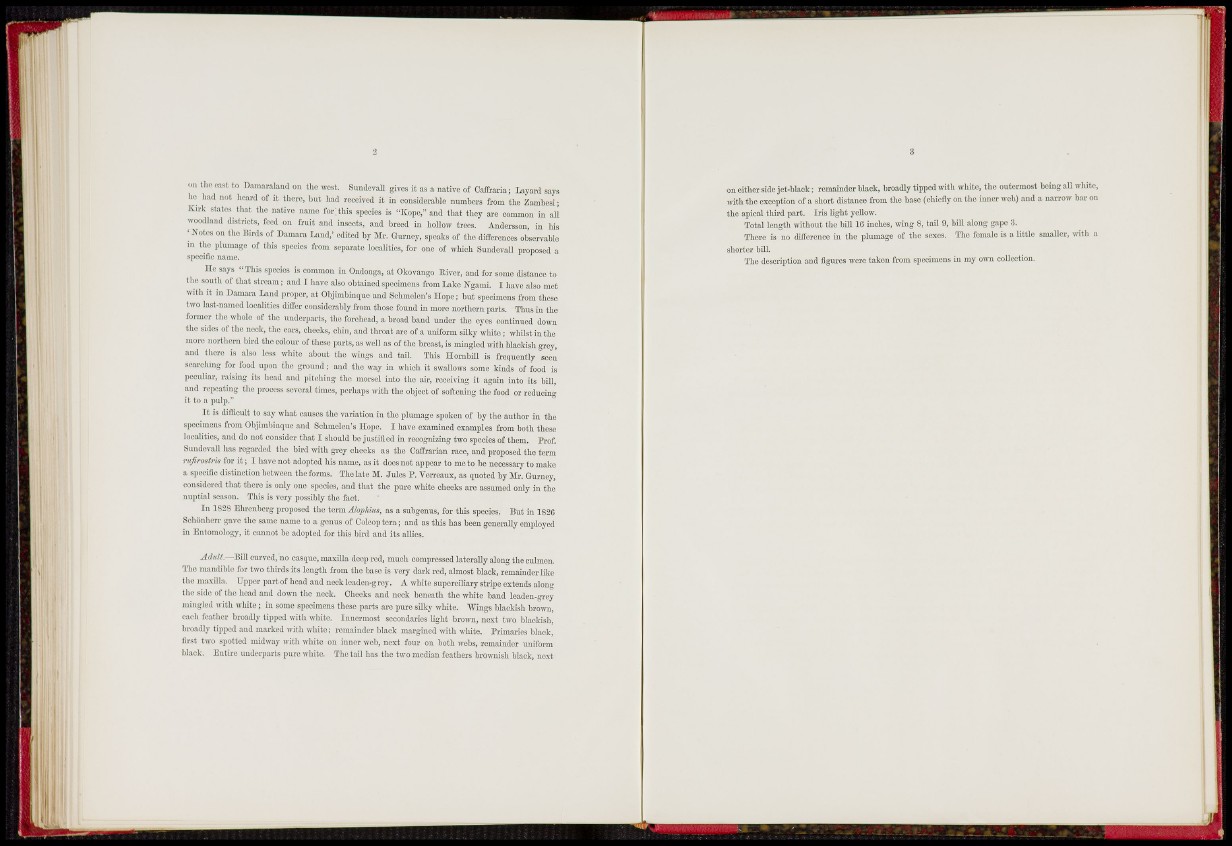
In
I :
..11 ll.n oast to Damnraland oti 11,g west. Sundcvall gives it as a native ot Caffmtia ; Layard says
lie liad not heard of it there, bat had reeeived it in considerable numbers from the Zambesi-
K.tk states tint the native name for; this speeies is "Kope," and that they are common in all
ivoodland districts, feed on fruit and insects, and breed in hoUow trees. Andcrsson, in his
•Notes on the lîirds of Damara Land,' edited by Mr. Gurney, speaks of the differences observable
m the plumage of this spccies from separate localities, for one of which Sundcvall proposed a
speeiflc name.
l i e says "This species is common in Ondonga, at Okovango Hiver, and for some distance to
the south of that stream : and I have also obtained specimens from Lake Ngami. I have also met
with it in Damara Land proper, at Objhnbinque and Sehmelen's Hope; but specimens from these
two last-named localities diifor considerably from those found in more northern pai-ts. Thus in the
former the whole of the umlcrparts, the forehead, a broad band under the eyes continued down
the sides of the neck, the ears, cheeks, chin, and throat arc of a uniform silky white ; whilst in the
more northern bird the colour of these parts, as well as of the breast, is mingled with blackish grey,
and there is also less white about the wiugs and tad. This Ilornbill is frequently seen
searching for food upon the ground ; aad the way in which it swallows some kinds of food is
peculiar, raising its head and pitching the morsel into the air, rceeiving it again into its bill,
and repeating the process several times, perhaps with the object of softening the food or reducing
it to a pulp."
I t is difficult to say what causes the variation in the plumage spoken of by the author in the
specimens from Objimbinque and Schmolen's Hope. I have emmined examples from both those
localities, and do not consider that I should bo justified in reeognizing two speeies of them. Prof.
Sundcvall has regarded the bird with grey cheeks as the Cailrarian race, and proposed the term
rnfirosiris for it ; I have not adopted his name, as it does not appear to me to be necessary to make
a spccifie distmetion between the forms. The late M. Jules P. Vcri-eaux, as quoted by Mr. Gurney,
considered that there is only one species, and that the pure white cheeks are assumed only in the
nuptial season. This is very possibly the fact.
In 1828 Ehrenberg proposed the tavm Alo^hms, as a subgenus, for this species. But m 1826
Schonhcrr gave the same name to a genus of Coleop tera ; and as this has been generally employed
in Entomology, it cannot be adopted for this bird and its allies.
curved, "no casquc, maxilla deep red, much eomprcssed laterally along the culmcn.
The mandible for two thirds its length from the base is very dark red, almost black, remainder like
the maxilla. Upper part of head and neck leaden-grey. A white superciKary stripe extends along
the side of the head and down the neck. Cheeks and neck beneath the white band Icaden-grey
mingled with white ; in some speoimcns these parts are pure silky white. Wings blackish brown,
cach feather broadly tipped with white. Innermost secondaries Ught brown, next two blackish'
broadly tipped and marked with white ; remainder black margined with white. Primaries black,
first two spotted midway with white on inner web, next four on both webs, remainder uniform
black. Entire nndeiimrts pure white. The tail has the two median feathers brownish black, ne.it
on either side jet-black; remainder black, broadly tipped with white, the outermost being all white,
with the cxeeption of a short distance from the base (chiefly on the inner web) and a narrow bar on
the apical third part. Iris light yellow.
Total length without the bin 16 inches, wing 8, tail 9, bill along gape 3.
There is no difference in the plumage of the sexes. The female is a little smaller, with a
shorter biU.
The description and figures were taken from specimens in my own collection.
ss